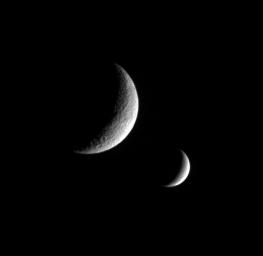
|
Envious Tethys
- Click the image above for a larger view
- Full-Res JPEG (481 x 469) (5.4 kB)
- Full-Res TIFF (481 x 469) (226.0 kB)
Caption:
The Cassini spacecraft captures this dual portrait of an apparently dead moon and one that is very much alive. Tethys, in the foreground, shows no signs of recent geologic activity. Enceladus, however, is covered in fractures and faults -- near its south pole in particular -- and spews icy particles into space from active vents.
Tethys' giant crater Odysseus lurks in the dark just west of the terminator. North on the moons is up.
The image was taken in visible light with the Cassini spacecraft narrow-angle camera on Nov. 29, 2005 at a distance of approximately 970,000 kilometers (600,000 miles) from Tethys (1,071 kilometers, or 665 miles across) and at a Sun-Tethys-spacecraft, or phase, angle of 122 degrees. Cassini was then 1.1 million kilometers (700,000 miles) from Enceladus (505 kilometers, or 314 miles across). Image scale is 6 kilometers (4 miles) per pixel on Tethys (at left) and 7 kilometers (4 miles) per pixel on Enceladus (at right).
Background Info:
The Cassini-Huygens mission is a cooperative project of NASA, the European Space Agency and the Italian Space Agency. The Jet Propulsion Laboratory, a division of the California Institute of Technology in Pasadena, manages the mission for NASA's Science Mission Directorate, Washington, D.C. The Cassini orbiter and its two onboard cameras were designed, developed and assembled at JPL. The imaging operations center is based at the Space Science Institute in Boulder, Colo.
For more information about the Cassini-Huygens mission visit http://saturn.jpl.nasa.gov . The Cassini imaging team homepage is at http://ciclops.org .
Cataloging Keywords:
| Name | Value | Additional Values |
|---|---|---|
| Target | Tethys | Enceladus |
| System | Saturn | |
| Target Type | Satellite | |
| Mission | Cassini-Huygens | |
| Instrument Host | Cassini Orbiter | |
| Host Type | Orbiter | |
| Instrument | Imaging Science Subsystem (ISS) | |
| Detector | Narrow Angle Camera | |
| Extra Keywords | Crater, Grayscale, Visual | |
| Acquisition Date | ||
| Release Date | 2005-12-30 | |
| Date in Caption | 2005-11-29 | |
| Image Credit | NASA/JPL/Space Science Institute | |
| Source | photojournal.jpl.nasa.gov/catalog/PIA07664 | |
| Identifier | PIA07664 | |
